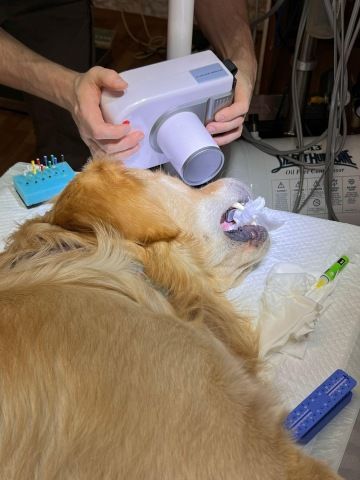Diagnostics - intraoral X-ray
3 years ago

How are dental x-rays taken?
The x-ray of your pet's teeth is similar to that of humans. An x-ray machine using a small amount of radiation is used to view the inside of your dog's teeth and those areas below the gum line that are hidden. Unlike humans, animals must be under general anesthesia for a dental X-ray, as it is practically impossible to get them to hold the plate in their mouth and not bite into it. You can read more about the anesthesia itself and what it all entails here.
Why is it important to do a dental x-ray?
Animals just can't tell us when their teeth are sick and some never show that they are in pain. In many cases, an intraoral x-ray is the only way we can tell that your pet has a serious dental problem that can be treated and the discomfort alleviated.
It should be noted that quality dental treatment requires x-rays of the teeth. Without an x-ray of the teeth, it is practically impossible to assess the condition of the periodontium, and diseases that occur below the level of the gums are invisible to the human eye.
How often should my dog's teeth be X-rayed?
An X-ray should be taken every time a tooth is missing, discolored or broken. Furthermore, in cases of swollen and inflamed gums, growths in the mouth or even bad breath. Even without these symptoms, it is recommended to take pictures of at least strategic teeth - the teeth of the blockbuster complex and canines - always when removing tartar. Remember that one human year is equal to 5-7 dog years, and humans routinely get dental x-rays at least once every 2 years for a preventative checkup.
Does my dog need to be anesthetized for x-rays?
Yes, without anesthesia, the x-ray sensor cannot be accurately positioned. In general, we use analgosedation (the same as when your animal goes for a hip assessment) to take the picture and a complete examination of the oral cavity, and only then do we switch to full anesthesia.
Should I worry about excessive radiation?
No. Currently, only a small amount of radiation is used to take dental X-rays. There are no reports of adverse radiation effects in animals that have been repeatedly exposed to radiation for examination or treatment of the oral cavity.




